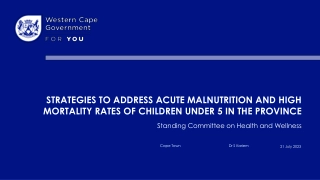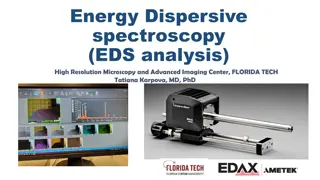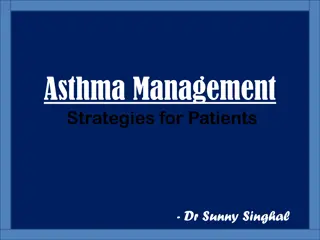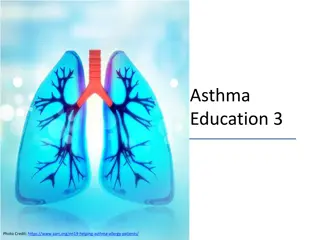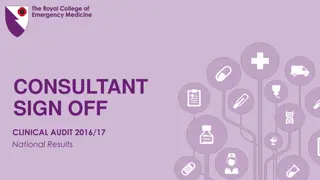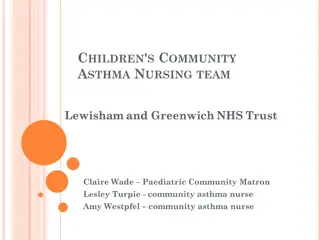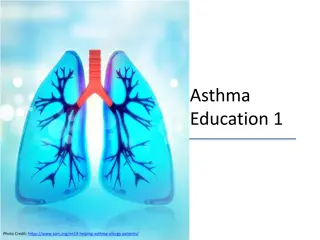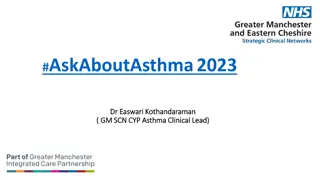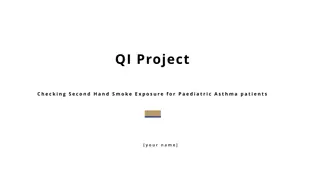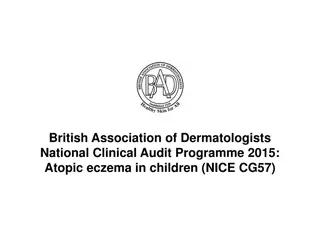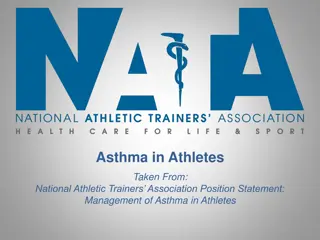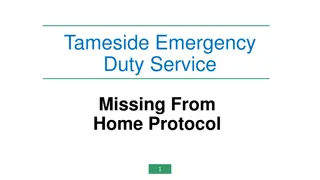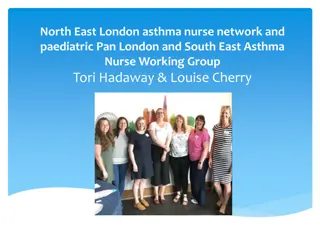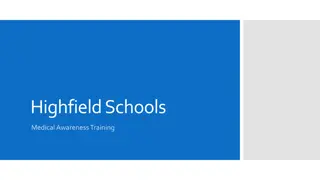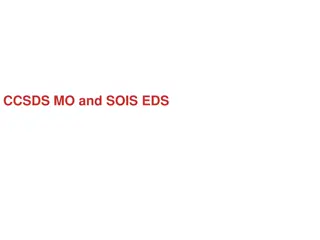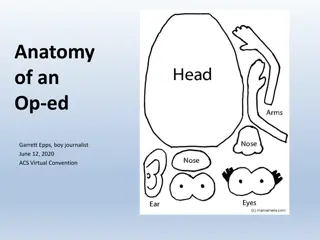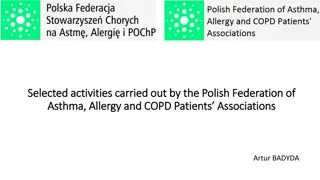Clinical Audit Results of Moderate to Acute Severe Asthma in EDs 2016/17
This clinical audit presentation showcases the national results of how Emergency Departments (EDs) are performing against the established audit standards for moderate to acute severe asthma in the year 2016/17. The objectives of the audit were to benchmark current performance, enable national and peer-to-peer comparisons, identify areas for improvement, and compare against previous performance in 2009/10 and 2013/14. The audit standards cover aspects such as oxygen therapy, vital signs monitoring, bronchodilator administration, steroid and magnesium sulfate usage, psychosocial considerations, and discharge protocols. The presentation includes information on national findings and executive summary graphs indicating the median national performance against the audit standards.
Download Presentation

Please find below an Image/Link to download the presentation.
The content on the website is provided AS IS for your information and personal use only. It may not be sold, licensed, or shared on other websites without obtaining consent from the author. Download presentation by click this link. If you encounter any issues during the download, it is possible that the publisher has removed the file from their server.
E N D
Presentation Transcript
MODERATE & ACUTE SEVERE ASTHMA CLINICAL AUDIT 2016/17 National Results
Contents This presentation shows how EDs are performing against the audit standards. For further information please see the national report at www.rcem.ac.uk/audits.
Audit objectives 1. To benchmark current performance in EDs against the standards 2. To allow comparison nationally and between peers 3. To identify areas in need of improvement 4. To compare against previous performance in 2009/10 and 2013/14
Standards Standard 1a. O2should be given on arrival to maintain sats 94-98% % 100 Standard type Fundamental 1b. O2should be prescribed on arrival to maintain sats 94-98% 2a. As per RCEM standards, vital signs should be measured and recorded on arrival at the ED 2b. Patients with any recorded abnormal vital signs should have a further complete set of vital signs recorded in the notes within 60 minutes of the first set 3. High dose nebulised 2agonist bronchodilator should be given within 10 minutes of arrival at the ED 80 Developmental 100 Fundamental Developmental 80 100 Fundamental 4. Add nebulised Ipratropium Bromide if there is a poor response to nebulised 2agonist bronchodilator therapy 100 Fundamental
Standards Standard 5. If not already given before arrival to the ED, steroids should be given as soon as possible as follows: % Standard type 5a. within 60 minutes of arrival (acute severe) 100 Fundamental 5b. within 4 hours (moderate) 100 Fundamental 6. Intravenous Magnesium 1.2 - 2g over 20 minutes to be given to adults with acute severe asthma who do not respond well to bronchodilators 80 Developmental 7. Evidence of consideration given to psychosocial factors in adults prior to discharge 50 Aspirational
Standards Standard 8. Evidence of assessment before discharge that: % Standard type 8a. the patient s inhaler TECHNIQUE is satisfactory 80 Developmental 8b. the patient s inhaler TYPE is satisfactory 80 Developmental 9. Discharged patients should have oral prednisolone prescribed 100 Fundamental 10. Written discharge advice given to the patient 80 Developmental 11. GP or clinic follow-up arranged according to local policy for discharged patients within 2 working days 80 Developmental
Executive summary This graph shows the median national performance against standards for this audit Higher scores (e.g. 100%) indicate higher compliance with the standards and better performance.
Summary of national findings National Results RCEM Standard 2016/17 (14043 cases) 2013/14 2009/10 UQ LQ M M M STANDARD 1a: O2should be given on arrival to maintain sats 94-98% STANDARD 1b: O2should be prescribed on arrival to maintain sats 94-98% STANDARD 2a: As per RCEM standards, vital signs should be measured and recorded on arrival at the ED STANDARD 2b: Patients with any recorded abnormal vital signs should have a further complete set of vital signs recorded in the notes within 60 minutes of the first set - 12% 19% 30% 85% 100% - - 80% 1% 4% 8% 15% 26% 40% 48% 100% 100% - 80% 4% 11% 19% 6%
Summary of national findings National Results RCEM Standard 2016/17 2013/14 2009/10 UQ LQ M M M STANDARD 3: High dose nebulised 2 agonist bronchodilator should be given within 10 minutes of arrival at the ED STANDARD 4: Add nebulised Ipratropium Bromide if there is a poor response to nebulised 2 agonist bronchodilator therapy 100% 12% 25% 36% 8% 12% 100% 68% 77% 87% 88%
Summary of national findings National Results RCEM Standard 2016/17 2013/14 2009/10 UQ LQ M M M If not already given before arrival to the ED, steroids should be given as soon as possible: STANDARD 5a: within 60 minutes of arrival (acute severe) See cell below 6% 19% 32% 30% 100% 12% 28% 43% 66% 100% STANDARD 5b: within 4 hours (moderate) - STANDARD 6: Intravenous Magnesium 1.2 - 2g over 20 minutes to be given to adults with acute severe asthma who do not respond well to bronchodilators 23% 38% 60% - 80% -
Summary of national findings National Results RCEM Standard 2016/17 2013/14 2009/10 UQ LQ M M M STANDARD 7: Evidence of consideration given to psychosocial factors in adults prior to discharge 50% 0% 6% 18% - - Evidence of assessment before discharge that: STANDARD 8a: the patient s inhaler TECHNIQUE is satisfactory STANDARD 8b: the patient s inhaler TYPE is satisfactory 0% 7% 14% - - 80% 1% 9% 20% - - 80%
Summary of national findings National Results RCEM Standard 2016/17 2013/14 2009/10 UQ LQ M M M STANDARD 9: Discharged patients should have oral prednisolone prescribed 40% 52% 71% 62% 69% 100% STANDARD 10: Written discharge advice given to the patient 4% 8% 25% 80% - - STANDARD 11: GP or clinic follow-up arranged according to local policy for discharged patients within 2 working days 7% 16% 28% 63% 80% -
Casemix How do patients attending EDs compare nationally? This section helps you understand more about the case mix and demographics of the patients.
Patient arrival Sample: all patients There is a relatively even distribution of asthma attendances over the weekdays, peaking late evening. On Sunday evenings, there appears to be an increased incidence of attendance which may reflect reduced access to GP services over the weekend but the aetiology is not known. It is certainly reflective of ED attendances in general.
Age of patient Sample: all patients The majority of patients included in this audit were adults with 36% being children.
Symptom severity Sample: all patients On presentation, 62.7% of patients had moderate asthma versus 33.2% acute severe asthma. However, in 4.1% of cases, the asthma severity level was not recorded.
Was the patient admitted or discharged? Sample: all patients This chart shows that the majority of patients were discharged, emphasising the importance of robust discharge arrangements.
Audit results How did EDs perform against the standards? This section helps you understand more about how EDs performed nationally.
Oxygen given on arrival STANDARD 1a: O2should be given on arrival to maintain sats 94-98%. Sample: all patients
Oxygen prescribed on arrival STANDARD 1b: O2should be prescribed on arrival to maintain sats 94-98% Sample: all patients
Nebulised 2 agonist bronchodilator STANDARD 3: High dose nebulised 2 agonist bronchodilator should be given within 10 minutes of arrival at the ED. Sample: all patients
Nebulised Ipratropium Bromide STANDARD 4: Add nebulised Ipratropium Bromide if there is a poor response to nebulised 2 agonist bronchodilator therapy Sample: all patients excluding Q7 = no, not needed
Vital signs measured and recorded STANDARD 2a: As per RCEM standards, vital signs should be measured and recorded on arrival at the ED. Sample: all patients
Abnormal vital signs STANDARD 2b: Patients with any recorded abnormal vital signs should have a further complete set of vital signs recorded in the notes within 60 minutes of the first set. Subsample: Q9=yes (except capillary refill which only includes children) (n=9598)
Steroids given (acute severe asthma) If not already given before arrival to the ED, steroids should be given: STANDARD 5a: within 60 minutes of arrival (acute severe).
Steroids given (moderate asthma) If not already given before arrival to the ED, steroids should be given: STANDARD 5a: within 4 hours (moderate).
Intravenous Magnesium given STANDARD 6: Intravenous Magnesium 1.2 - 2g over 20 minutes to be given to adults with acute severe asthma who do not respond well to bronchodilators. Subsample: Q3= 16 years or over AND Q10= Acute severe , EXCLUDE Q12= No reason given and No paediatric
Psychosocial factors considered STANDARD 7: Evidence of consideration given to psychosocial factors in adults prior to discharge. Subsample: Q3= 16 years or over AND Q14= Discharged , EXCLUDE Q15 No paediatric patient AND No reason given
Inhaler technique assessed Evidence of assessment before discharge that: STANDARD 8a: the patient s inhaler TECHNIQUE is satisfactory Subsample: Q14= Discharged , EXCLUDE Q16= Not assessed - reason given
Inhaler type assessed Evidence of assessment before discharge that: STANDARD 8b: the patient s inhaler TYPE is satisfactory Subsample: Q14= Discharged , EXCLUDE Q17= Not assessed - reason given
Oral prednisolone prescribed STANDARD 9: Discharged patients should have oral prednisolone prescribed Subsample: Q14= Discharged EXCLUDE Q18= Not prescribed - reason given
Written discharge advice STANDARD 10: Written discharge advice given to the patient. Subsample: Q14= Discharged
Intravenous Magnesium given STANDARD 11: GP or clinic follow-up arranged according to local policy for discharged patients within 2 working days. Subsample: Q14= Discharged
Recommendations 1. Departments should consider how oxygen is prescribed and ensure that all asthmatics are prescribed it on arrival to maintain saturations of 94-98%, preferably with a 2 agonist if required. 2. Vital signs are an important measure of both severity of illness and detecting treatment efficacy. Departments should consider an education programme for staff to improve this and conduct regular local audits/QIPs to ensure compliance with particular focus on timing and peak flow measurement. 3. Consideration should be given to psychosocial factors in assessment of severity and discharge and departments should consider this in their education programme.
Recommendations 4. On discharge, all moderate-severe asthmatic patients should have a written management plan in place which includes assessment of inhaler type, technique, steroids and follow-up. 5. A proforma should be considered by departments to improve documentation and act as an aide memoir for assessment, discharge/admission criteria and dosing of medication.
Next steps Read the full report at www.rcem.ac.uk/audits Action planning Rapid cycle quality improvement Contact other EDs for tips & solutions


